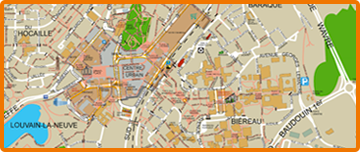

Contact
us

Discovery tour
Newsletter
Get tourist news on Ottignies-Louvain-la-Neuve


Urban and sustainable design
A dream that became reality
We owe the idea for the city’s design largely to Michel Woitrin, general trustee of UCL, and Professor Raymond Lemaire, specialist in ancient cities.They wanted a site that respected the densely inhabited landscape, where urban functions mix and where the city itself promotes meetings and dialogue between students and non-students.
The history of Louvain-la-Neuve...
The 9 Commandments
To guide the construction of the city, overall development plan and city-planning principals were established. Two fundamental objectives were defined : university functionality and the quality of urban life.These two objectives were broken down in 9 major commandments:
- A city on a human scale
- The university is integrated into the city
- The university is the engine of the city
- A pedestrian city (Diameter of the city is less than 2.5 km)
- A urban atmosphere from the beginning
- A town center with a human face
- The site is the matrix of the city
- A well-defined entity in the landscape, integrated into its surrounding environment
- A modular design, allowing for future urban development
A special town center
The heart of the city is build on a 12.6-hectare and 39-cm thick concrete slab. It is on this concrete slab, wich covers public roads, parking lots and the train station, that the buildings were constructed. All of the normal functions of a city can be found here: shops, administrative departments, cultural activities... everything mixes with the residential functions and with university activities.Accessibility for all
The town was designed for all users in mind and is accessible to all at all levels. The train brings the commuters to the centre and regular bus connections leave from Louvain-la-Neuve to various destinations.
Each staircase is doubled up by a ramp or a lift to enable persons with limited mobility, pushchairs, elderly people, bikes, scooters, etc. to be able to circulate easily.
Special podotactile tiles have been laid on pavements for the visually impaired, or as paths on squares. A vast project to improve the public areas is in place and new achievements are attained each year.
Thanks to these initiatives the town of Ottignies-Louvain-la-Neuve was awarded the 2013 European EDEN for Destinations of Touristic Excellence for the theme “Tourism and accessibility”.
A sustainable design
The goal to preserve green spaces and respect the environment influenced the overall design of Louvain-la-Neuve. Examples, among others: respect of the landscape, deterring car use, a double draining network separating rain water from used water, use of natural gas for heating, cogeneration…
The natural spaces from the past, namely woods, planted slopes and paths, were preserved.
Sustainable development is a constant concern for Ottignies-Louvain-la-Neuve. To create all aspects of the region (mobility, education, and health, for example) while taking into consideration energy, water, green spaces, sports and culture, the city implements projects that are compatible with sustainable development and environment preservation.
Specific locations in the city can be pointed out concerning this theme :
- Baraque District, a surprising alternative district in Louvain-la-Neuve
- The Sustainable Development House, Gingko Biloba, a true window to ecotechnology in Louvain-la-Neuve. Created by the UCL and the City of Ottignies-Louvain-la-Neuve, this place seeks to promote the citizen efforts to ensure the viable future of our planet. Documents, exhibitions and advice about energy economy, eco-consumption, climate, biodiversity in Belgium and the environment are available.
For information on activities and events : www.maisondd.be
- The Pleiad House, an experimental dwelling place and one of the first example of an energy efficient building in the Bruyères district of Louvain-la-Neuve. You will find all of the scientific and architectural information of the building at www-climat.arch.ucl.ac.be.
- Recyhouse, or recycled house in Limelette is a building entirely made of recyclable materials; it is the concrete realization of the BBRI, the Belgian Building Research Institute. This test building is currently occupied by offices, but group visits can be nevertheless organized. Want to learn more? Call +32 (0)2 655 77 11.
Collective management
This precious heritage and its preservation are strictly linked to the participative management of all of the players in the region. Residents, students, institutions and the university, enlivened by a collective and pioneer spirit, gave birth to the culture of the community decision, a shocking success and a model for sustainable development.







